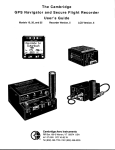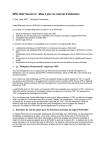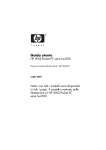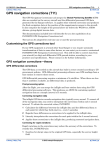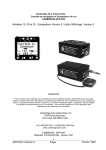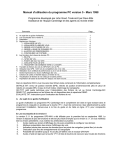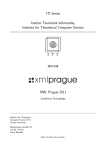Download GPS-NAV Version 6.0 -- User's Guide Update
Transcript
GPS-NAV Version 6.0 -- User's Guide Update D. Ellis March, 2000 This ROM Version upgrades the GPS-NAV with the following features and bug fixes: Items 1-4 were first introduced in GPS-NAV Version 5.4 1. 2. 3. 4. Support for the IGC-mandated "Pilot Event Mark" Password activation of GPS-NAV for advanced Palm-NAV software features Battery power support for the Palm-NAV Minor bug fixes. Version 6.0 (Improves support for Palm-NAV Version 4 software.) 5. 6. 7. 8. 9. Pressure altitude is sent from a non-activated GPS-NAV to the Palm-NAV. GPS Satellite data is added to messages sent from GPS-NAV to Palm-NAV.. Data synchronization is improved for messages between GPS-NAV and Palm-NAV. Removes a bug that caused intermittent failure of manual fast logging. Removes a bug that rarely caused the arrival beep to occur outside the arrival radius. 1. The IGC-mandated "Pilot Event Mark" All IGC-Approved Secure Flight Recorders are required to support a "Pilot Event Mark" (PEV). The GPS-NAV does this in the following way: A PEV is entered in the flight log when the GPS-NAV "ON" key is pressed or when a TASK is started. The PEV also causes a normal position fix to be logged within 2 seconds. The position fix contains GPS time and pressure altitude as well as GPS position, so it completely documents the PEV. Fifteen fixes at 2 second intervals are logged after the "ON" key is pressed. The GPS-NAV give a short audio "beep" when the PEV is logged. This confirms the PEV. The GPS-NAV LCD screen sequences through a series of messages when the "ON" key is pressed. Pressing the "GO" key cancels the message sequence. The GPS-NAV used without an LCD screen also supports the PEV feature. A pushbutton switch attached to a six conductor cable is plugged into the GPS-NAV "Display" port. Pressing the button is the same as pressing the LCD screen "ON" key. You may fabricate the cable using one of the extra 6 conductor "test' cables shipped with the GPS-NAV Flight Recorders. Wiring instructions are included below. The Cambridge Palm-NAV also supports the PEV feature. 2. Password activation of advanced Cambridge Palm-NAV software features Palm-NAV software is the intellectual property of Cambridge Aero Instruments. Software development and support is expensive. Because illegal copies of Palm-NAV software can be made easily with a PC, Cambridge has chosen to protect its intellectual property rights with passwords stored by GPS-NAV starting with Version 5.5 firmware. The password system is based on GPSNAV serial number. This system is designed for future low-cost Palm-NAV upgrades via the Cambridge Aero Internet Web page. Page 1 03/22/00 3. Battery power support for the Palm-NAV Palm-size-PCs running Windows CE have reasonable battery life when used without serial data communication. The Cambridge Palm-NAV requires continuous serial communication with the GPS-NAV. Palm-size-PCs have very short battery life when operated this way. Therefore, Cambridge GPS-NAV Version 5.4 and later supplies +5 Volt power to the Palm-size-PC via serial datacom cable pin 8. Pin 5 is the power supply ground. 4. Minor software "bug" fixes in Version 5.4 a. Short logging interval for Navpoints more than 300 km distance. If the GPS-NAV is set for variable rate logging, and if the active Navpoint is more than 300 km away, then the GPS-NAV logs at the fast interval. On a very long flight logged at 6 and 2 second intervals, the GPS-NAV can run out of memory. This problem has been solved in Version 5.4 b. Leap Year bug. This problem was discovered during an investigation for possible Y2K problems. No Y2K problems have been found. However, If a flight log is being recorded at midnight UTC, December 31 at the beginning or end of a leap year, the flight log is divided into two parts. This problem has been solved in Version 5.4. c. Behavior with Westerboer 921 Glide Computer Earlier GPS-NAV versions left information not required by Cambridge Aero Flight Computers out of transmitted NMEA sentences. This causes problems with the Westerboer flight computer. Starting with Version 5.4, the GPS-NAV transmits complete NMEA $GPRMB and $GPRMC sentences. 5. Pressure altitude is sent from a non-activated GPS-NAV to the Palm-NAV. This feature enables pilots to show differential final glide altitude when Palm-NAV Version 4 is used with a non-activated GPS-NAV. 6. GPS Satellite data is added to messages sent from GPS-NAV to Palm-NAV. This features helps GPS problem diagnosis when Palm-NAV Version 4 is used. 7. Data synchronization is improved for messages between GPS-NAV and Palm-NAV. Previous versions occasionally stopped sending messages between the GPS-NAV flight recorder, the GPS-NAV LCD screen, and the Palm-NAV. 8. Removes a bug that caused intermittent failure of manual fast logging. When the ON key is pressed during flight, a PEV mark is added to the flight log. The GPS-NAV flight recorder is supposed to then log 15 points at 2 second intervals. Version 6 firmware fixes a bug that occasionally caused this to not happen. Page 2 03/22/00 9. Removes a bug that rarely caused the arrival beep to occur outside the arrival radius. Earlier versions truncated a number indicating distance to the goal point. In very rare instances, this caused the GPS-NAV to display the “Arrival” message before the arrival distance was achieved. The error could be up to 100 meters. This computational problem has been solved. Pilot Event Marker Switch for Flight Recorder without Display blu ylw grn red blk wht Bill of Materials Connector Wire Switch CO-040 (six position RJ connector) WA-041 (six conductor modular cable) Your choice This view is with the locking tab facing up. The connector plugs into the "Display" port on the GPS Flight Recorder. Connect the switch to the green (grn) and black (blk) leads. The switch contacts must be normally open. Closing the switch momentarily makes a Pilot Event Mark (PEV). Page 3 03/22/00



